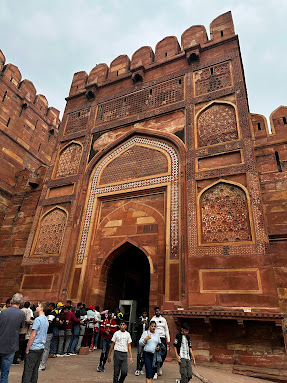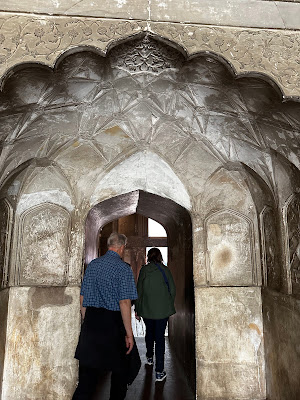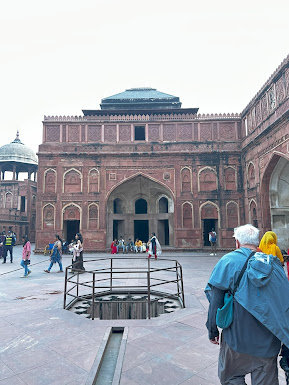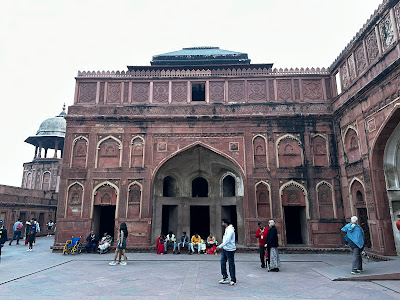December 26-27, 2024
Our next destination was Agra, home to the world-renowned Taj Majal, but to get there from Varanasi we had to fly to Delhi, spend the night, then sit four hours in a minivan to drive 150 miles, which gives you an idea of what the roads are like in India.
Fortunately, we had another luxury stay in Delhi in the Marriott Hotel. It wins the prize for the most beautiful lobby.
I was intrigued by this Christmas display with a griffin in the center, but I have since learned that the griffin is the Marriott Hotel's custom logo found in their hotels throughout the world.
Like almost all of our upper-end hotels, this one had a doorman in traditional dress. I don't know if this is a British colonial thing or a truly Indian culture thing. I suspect it is the former.
About half-way through the long drive we made a bathroom and snack stop. I like how this bathrooms are labeled "Public Conveniences."
KFC, Pizza Hut, and Subway are regular fast food places in India. No thanks. I grabbed something (I can't remember what) from the Indian fast food restaurant Vaango!
We arrived at the Agra Fort (aka Red Fort) in the early afternoon. I think it was the most spectacular thing we had seen up until this point in our trip. The initial stages of the fort were built in the early 1500s, and it was the main residence of the Mughal emperors from the time of its construction until 1638, which is when the capital was shifted from Agra to Delhi. It is where the most famous Mughal emperors, Humayun and Akbar, were crowned in 1565 and 1573, respectively. (It was Akbar's grandson who built the Taj Mahal just 1.6 miles from this site in 1648.) The Agra Fort was designated a UNESCO World Heritage Site in 1983.
This was another one of those magnificant places that we could not believe we had never heard of. It is astounding that the builders had the design and engineering skills in 1500 to create even the beginnings of a place like this. When Akbar ascended to the throne, he undertook a significant rebuilding of the fort. Historians say 4,000 builders worked on it every day for eight years to complete Akbar's vision, but it wasn't truly finished until Akbar's grandson, Shah Jahan, completed the current version in the 1660s.
This more recent embellishment made me smile.
The fortress walls enclose 94 acres, and within that property are many significant buildings, including the Hall of Public Audience:
In the background below left is the Moti Masjid ("Pearl Mosque"), a Sunni mosque built entirely of white marble between 1646-1653 century by Shah Jahan (the Taj Mahal guy). A red standstone wall surrounds it.
The Khas Mahal was the Mughal emperor's private residence.
That's quite the fancy garden. It looks like a giant jigsaw puzzle.
In his later years, an ailing Shah Jahan named one of his three sons as his successor, which led to a war among the sons. The winner executed the other two. He then placed his father under house arrest in this building in Agra Fort for his last eight years. The Taj Mahal, which Shah Jahan constructed as a mausoleum for his wife after her death during childbirth, can be seen from the balcony, and legend has it that Shah Jahan would spend hours each day gazing across the valley and longing to be with his wife again. (We could just barely make out the Taj through the air pollution.) She was so close, but he could not visit her. When Shah Jahan died in 1666, we was at last laid to rest next to his beloved in the Taj.
This octagonal tower sits atop the Mussaman Burj and likely offers the best view of the Taj.
Someone said all those niches in the walls were for jewelry storage. I have no idea if that is true or not.
The door that is underneath it is not too shabby either.
I think Mughal/Islamic architects are the world's best door designers.
I think this is the Shah Jahani Mahal, an example of Shah Jahan's early efforts to transform existing red stone buildings into white marble structures.
"Scribing" is not a word I hear in everyday American English. Maybe in British English?
In the courtyard is this . . . laundromat? hot tub? swimming pool? sewer? I am not sure.
It is obvious why the Agra Fort is also called the Red Fort. Maybe it should also be called the More and More Fort. The wonders never seem to cease.
A final glance back in time to Agra's version of Shangri-La.


































































(Bob) Agra Fort really is spectacular, and spectacularly massive, although I'm not sure it beats the temple complex we visited in Delhi in terms of intricacy of architecture.
ReplyDelete